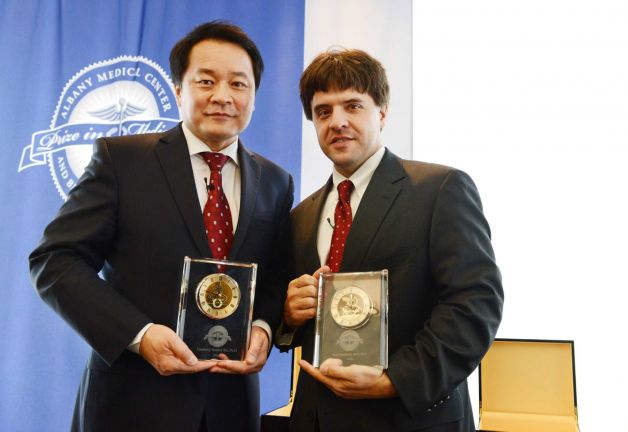The scientists who received the Albany Medical Center Prize in Biomedicine and Biomedical Research this year don't do work that is easy to explain to a patient.
Or even, necessarily, to the dean of a medical college.
"Let me try to explain this," Albany Medical College Dean Vincent Verdile said with a little laugh at the Hilton Garden Inn Friday morning, as he introduced the work of Karl Deisseroth of Stanford University and Xiaoliang Sunney Xie of Harvard University, who share this year's $500,000 Albany Med Prize.
The importance of their work lies in the avenues of other research that Deisseroth and Xie have opened, and the promise that the technologies they developed will accelerate medical discoveries in psychiatric disorders, cancer and other areas.
Deisseroth, 43. whose mother hails from Slingerlands, was recognized for developing methods that help scientists understand the brain's circuitry and how specific neurons play a role in Parkinson's disease, addiction and depression, as well as in normal processes like memory and learning.
Xie, 52, was selected for work that allows scientists to pinpoint genomic changes in a single cell. His research has major implications in cancer research and in-vitro fertilization.
"I'm delighted that our field research eventually can make some contribution to medicine," Xie said in accepting his award.

Xiaoliang Sunney Xie (left)
The scientists know each other from winning previous awards that encouraged collaboration. There may be avenues for combining their research in novel ways, they said, especially in advancing personalized medicine, which holds the promise of tailoring medical treatments to individual patients.
Deisseroth pioneered a groundbreaking technology called optogenetics. He and his colleagues developed a way to insert light-producing genes from microorganisms like bacteria and algae into the brain cells of mice, rats and monkeys to illuminate specific kinds of neurons and see how they work. He later introduced another technology called Clarity, which he said makes brains or other tissue transparent so that light can pass through or be used to label the structures within.
Since the 1990s, Xie has developed methods of probing previously invisible molecules in living organisms with light-induced signals. More recently, his team developed a technology that allows the pinpointing of genetic changes in a single cell. The research is important in detecting 7,000 known genetic diseases that result from a mutation at a particular point of the cell's DNA, Xie said.
Being able to detect these point mutations could one day lead to the ability to diagnose cancers at early stages without surgery, Xie said.
In the field of psychiatry, the Stanford scientist said, that kind of specificity is a ways off, although the goal of precision diagnostics is similar. "In the brain, we don't know yet what to measure," Deisseroth said.
Louise Deisseroth was among the 75 or so people in attendance to see her son receive his award. She beamed when asked if she found it special that her son won an award with a connection to her hometown, saying that the location was her reason for coming to the ceremony. She spent her childhood in Slingerlands, from 1945-1963, and has spent most of her adult life in Maryland. She hadn't visited in years, she said.
In private remarks after the ceremony, Karl Deisseroth recalled visiting his grandparents in Slingerlands as a child, with his two sisters. His grandfather was an insurance broker, Deisseroth said, and he especially remembered playing on their big, beautiful lawn.
Louise Deisseroth first learned about the Albany Med Prize several years ago while visiting her son at Stanford, she said. Another professor at the California university, Stanley Cohen, won the prize in 2004. The prize is listed on a wall there, among other prestigious medical awards, including the Nobel Prize and Lasker Award.
One of the nation's largest prizes for science and medicine, the Albany Med Prize was established in 2000 by the late Morris "Marty" Silverman, a New York City businessman and philanthropist who grew up in Troy. A commitment of $50 million from the Marty and Dorothy Silverman Foundation allows for the prize to be awarded annually for 100 years.
Asked by a high school student in the audience whether they would use the prize money to further their research, Xie said to laughter, "I have three kids," and Deisseroth added, "I have four kids."
Both scientists noted that it is getting tougher to pursue important research in light of federal research funding cuts.
"This recognition helps at the least psychologically," Deisseroth said, "even if we're using it for college tuition."
Reported by: Claire Hughes
chughes@timesunion.com • 518-454-5417 • @hughesclaire
Source: http://www.timesunion.com/news/article/Two-scientists-in-Albany-to-share-500-000-6265703.php